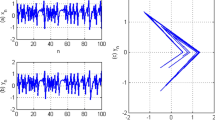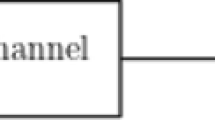Abstract
The superior performance of the binary turbo codes has stimulated vigorous efforts in generating bandwidth efficient modulation schemes adhering to these codes. Several approaches for the integration of turbo-coding and modulation have emerged in recent years but none seem to dominate. In the bit interleaved coded modulation (Bicm) scheme is used to achieve high bandwidth and power efficiency, while separating coding and modulation. As is now well known, theBicm scheme achieves capacity remarkably close to the constellation channel capacity. The turbo-Bicm scheme enjoys high coding diversity (well suited for fading channels), high flexibility as well as design and implementation simplicity, while maintaining good power efficiency. The system comprises one standard turbo code, an interleaver, a mapper and a modulator at the transmitter, corresponding to a demodulator, a de-interleaver and a turbo decoder at the receiver. A modified system, which improves on performance by incorporating the demodulation in the iterative decoding procedure, is investigated, and some performance gain is demonstrated, especially for low rate codes. Information theoretic arguments for the somewhat minor potential improvement in performance are detailed. The preferred mapper and interleaver for this system are considered. Extending previous works, for higher level modulations, we analyze a system including a convolutional code, an interleaver, a differential encoder (De), a mapper and a modulator at the transmitter. As for theBpsk modulation, the serial concatenation of a convolutional code withDe outperforms the single convolutional code. The serial concatenation withDe approach is analyzed also for a turbo code, where it is found to fail in achieving performance improvement. Several structures for the serial concatenation withDe are examined. These results are substantiated through the ‘spectral thinning’ phenomena of the weight distribution of the convolutional and turbocodes.
Résumé
Les bonnes performances des turbo codes binaires ont suscité de gros efforts de recherche pour associer ces codes aux modulations à grande efficacité spectrale. Plusieurs approches ont été proposées durant ces dernieres années, mais aucune ne semble s’imposer. Dans cet article le principe de la modulation codée avec entrelacement de bits (Bicm) est utilisé pour atteindre une efficacité spectrale élevée et de forts rendements en puissance, tout en séparant le codage et la modulation. Le systèmeBicm, c’est maintenant bien connu, permet d’atteindre une bonne efficacité spectrale. Le système turbo-Bicm apporte une importante diversité de codage (bien adaptée aux canaux à évanouissement), une grande flexibilité aussi bien en ce qui concerne la simplicité de conception et d’implantation que du rendement de puissance. Le systéme comprend, du coté émetteur, un turbo code standard, un entrelaceur, un codeur binaire à symbole et un modulateur. Le récepteur est constitué d’un démodulateur, d’un désentrelaceur et d’un turbo-décodeur. Un systeme modifié permettant d’améliorer les performances en intégrant la démodulation dans le processus de décodage itératif, est décrit. L’amélioration des performances est démontrée, en particulier dans le cas des codes à faible rendement. Des propositions théoriques conduisant à des améliorations mineures potentielles des performances sont détaillées. Développant de précédents travaux sur les modulations de haul niveau, un système incluant à l’émission un code convolutif, un entrelaceur, un codeur différentiel, un codeur binaire à symbole et un modulateur est analysé. Pour la modulationMdp2, la concaténation série d’un code convolutif et d’un codeur différentiel conduit à de meilleures performances qu’un simple code convolutif. La concaténation série basée sur un codage différentiel est analysée égalemenl pour un turbo code. Dans ce cas, il n’y a pas d’amélioration des performances. Plusieurs structures pour la concatenation série avec un codeur différentiel sont étudiées. Les résultats sont justifiés par les phénomènes de « rétrécissement spectral » de la distribution des poids dans les codes convolutifs et les turbo codes.
Similar content being viewed by others
References
Berrou (C.). Glavieux (A.), Thitimajshima (P.). Near Shannon limit error-correcting coding and decoding: turbocodes,Proceedings of ICC’93, Geneva, Switzerland, pp. 1064–1070, (May 1993).
Ungerboeck (C.). Channel coding with multilevel/phase signals,IEEE Trans. Inform. Theory,28, pp. 56–67, (Jan. 1982).
Imai (H.), Hirakawa (S.). A new multilevel coding method using error correcting codes,IEEE Irons. Inf. Theory,23, pp. 371–377, (May 1977).
Viterbi (A. J.), Wolf (J. K.), Zehavi (E.), Padovani (R.). A pragmatic approach to trellis-coded modulation,IEEE Communications Magazine,27, no. 7, pp. 11–19, (1989).
Le Goff (S.). Glavieux (A.), Berrou (C.). Turbo codes and high spectral efficiency modulation.International Conference on Communications (ICC’94). pp. 645–649, (May 1996).
Barbulescu (S. A.), Farrel (W.). Bandwidth efficient turbo coding for high speed mobile satellite communications, inInternational Symposium on Turbo Codes and Related Topics, (Brest, Fr.), pp. 119–126,(1997).
Huber (J.). Multilevel-codes: distance profiles and channel capacity, inITG-Fachberichte, 130, pp. 305–319, (1994).
Huber (J.), Wachsmann (U.). Capacities of equivalent channels in multilevel coding schemes.Electronics Letters.30, pp. 557–558, (March 1994).
Wachsmann (U.), Huber (J.). Power and bandwidth efficient digital communication using turbo codes in multilevel codes,Europ. Trans. Telecommun. (ETT).6, pp. 557–567, (Sep.- Oct. 1995).
Fischer (R.), Huber (J.), Wachsmann (U.). Multilevel coding, Aspects from information theory, inProc. CTMC at IEEE Global Telecommun. Conf. (Globecom’96) pp. 26–30, London, UK. (Nov. 1996).
Wachsmann (U.), Fischer (R.), Huber (J.). Multilevel coding: basic concepts, capacity, and rate design, submitted toIEEE Trans. Inf. Theory.
Huber (J.), Wachsmann (U.). On set partitioning strategies for multilevel coded modulation schemes, inProc. Mediterranean Workshop on Coding and Information Integrity, Palma de Mallorca, Spain, (Feb.-March 1996).
Huber (J.), Wachsmann (U.), Fischer (R.). Coded modulation by multilevel codes : overview and state of the art. inITG- Fachberichte, Conference Records, Aachen, Germany, (March 1998).
Wachsmann (U.), Fischer (R.), Huber (J.). Multilevel coding: dimensionality of the constituent signal set, labeling, and hard decision decoding, submitted toIEEE Trans. Inf. Theory.
Wachsmann (U.), Fischer (R.), Huber (J.). Multilevel coding : distance profile and signal shaping, submitted toIEEE Trans. Inf. Theory, (1997).
Wachsmann (U.), Fischer (R.), Huber (J.). Multilevel coding: use of hard decision in multistage decoding,Proceedings Thirty-Fifth Annual Conference on Communication, Control, and Computing, pp. 966–975, Allerton House, Monticello, Illinois. (Sept. 29-Oct. 1, 1997).
Wachsmann (U.), Schramm (P.), Huber (J.), Comparison of coded modulation schemes for theAwgn and the Rayleigh fading channel,IEEE Int. Symp. Inf. Theory, ISIT ’98. p. 5. Cambridge. MA, USA, (August 16–21, 1998).
Schramm (P.). Multilevel coding with independent decoding on levels for efficient communication on static and interleaved fading channels, inProc. IEEE Int. Symp. Personal. Indoor and Mobile Radio Commun. (PIMRC), pp. 1196–1200. Helsinki, Finland, (Sept. 1997).
Kofman (Y.), Zehavi (E.), Shamai (S.), (Shitz). Performance analysis of a multilevel coded modulation system,IEEE Trans. Commun.,42, pp. 299–312, (Jan./Feb./March 1994).
Woerz (T.), Hagenauer (J.). Multistage coding and decoding, inProceedings of the IEEE Global Telecommunication Conference (Globecom’90), pp. 501.1.1–501.1. 6, San Diego. (Dec. 1990).
Woerz (T.). Hagenauer (J.). Iterative decoding for multilevel codes using reliability information, onProceedings of the IEEE Global Telecommunication Conference (Globecom’92), Orlando, (Dec. 1992).
Woerz (T.), Hagenauer (J.). Decoding ofM-psk-multilevel codes,European Transactions on Telecommunications.4, pp. 65–74, (May-June 1993).
Forney (G. D.)Jr.. Convolutional codes 1: algebraic structure,IEEE Trans. Inform. Theory,16, pp. 268–278, (Nov. 1970).
Robertson (P.), Woerz (T.). A novel coded modulation scheme employing turbo codes.Electronics Letters,31, pp. 1546–1547, (Aug. 1995).
Robertson (P.), Woerz (T.). A novel bandwidth efficient coding scheme employing turbo codes,in Proc. ICC 96, pp. 962–967, (June 1996).
Blackert (W.), Wilson (S.). Turbo trellis coded modulation, inProc. CISS’96,(1996).
Robertson (P.). An overview of bandwidth efficient turbo coding schemes, inInternational Symposium on turbo codes and Related Topics, (Brest, Fr.), pp. 103–110, (1997).
Robertson (P.), Woerz (T.). Bandwidth-efficient turbo trellis-coded modulation using punctured component codes,IEEE Journal on Selected Areas in Communications,16, no 2, pp. 206–218, (Feb. 1998).
Benedetto (S.), Divsalar (D.), Montorsi (G.), Pollara (F.). Bandwidth efficient parallel concatenated coding schemes,Electron. Lett.,31, no 24, pp. 2067–2069, (1995).
Benedetto (S.), Divsalar (D.), Montorsi (G.), Pollara (F.), Parallel concatenated trellis coded modulation, inProc. ICC’96, pp. 974–978, (June 1996).
Zehavi (E.). 8-Psk Trellis codes for a Rayleigh channel.IEEE Trans, on Commun..40. no 5, pp. 873–884, (May 1992).
Caire (G.), Taricco (G.), Biglieri (E.). Capacity of bit-interleaved channels,Electronics Letters,32, pp. 106–1061, (June 1996).
Caire (G.). Taricco (G.), Biglieri (E.). Capacity and cut-off rate of bit-interleaved channels.Proceedings of the International Symposium on Information Theory and its Applications ISITA 96. Victoria, Canada, (17–20 Sept. 1996).
Caire (G.), Taricco (G.), Biglieri (E.). Bit-interleaved coded modulation,IEEE Trans. on. Inform. Theory.,44, no 3, pp. 932–946, (May 1998).
Li (X.), Ritcey (J.). Bit-interleaved coded modulation with iterative decoding,IEEE Commun. Lett.,1, no 6, pp. 169–171, (1997).
Li (X.), Ritcey (J.). Low-complexity map decoding of trellis coded modulation with bit interleaving, inProc. 1997 IEEE Global Telecommunications Conf. (Clobecom'’97), Communication Theory Mini-Conference, pp. 28–32, (Nov. 97).
Li (X.), Ritcey (J.). Bit-interleaved coded modulation with iterative decoding using soft feedback,Electron, Lett.,34, no 10, pp. 942–943, (1998).
Forney (G. D.)Jr.. The viterbi algorithm,Proc. IEEE,61, pp. 268–276, (March 1973).
Bahl (L.), Cocke (J.).Jelinek (F.), Raviv (J.). Optimal decoding of linear codes for minimizing symbol error rate,IEEE Trans. Inform. Theory.20, pp. 284–287, (Mar. 1974).
Lodge (L.), Young (R.). Hoeher (P.), Hagenauer (J.). SeparableMap filters for the decoding of product and concatenated codes, inProc. IEEE International Conference on Commnication (ICC). Geneva, Switzerland, pp. 1740–1745, (May 1993).
Pietrobon (S. S.), Barbulescu (A. S.). A simplification of the modified bahl decoding algorithm for systematic convolutional codes.Int. Symp. Inform. Theory & its Applic., Sydney, Australia, pp. 1073–1077, (Nov. 1994).
Robertson (P.), Villebrun (E.), Hoeher (P.). A comparison of optimal and sub-optimalMap decoding algorithms operating in the log domain,ICC 95, Seattle, WA, USA, pp. 1009–1013, (June 1995).
Benedetto (S.), Montorsi (G.). Iterative decoding of serially concatenated convolutional codes,Electronics Letters,32, no 13, pp. 1186–1188, (June 1996).
Benedetto (S.), Montorsi (G.). Generalized concatenated codes with interleavers, inInternational Symposium on Turbo Codes and Related Topics. (Brest, Fr.), pp. 32–39, 1997.
Divsalar (D.), Pollara (E.). Serial and hybrid concatenated codes with applications, inInternational Symposium on Turbo Codes and Related Topics. (Brest, Fr.), pp. 80–87. (1997).
Battail (G.). On random-like codes, inProc. 4 th Canada. Workshop Inf. Theory, Lac Delage, Quebec, (28–31 May 1995).
Divsalar (R. D.), Dolinar (S.), Pollara (F.). Weight distributions for turbo codes using random and non random permutations,JPL TDA Progress Report,42-122, pp. 56–65, (15 August 1995).
Svirid (Y. V.). Weight distributions and bounds for turbo codes,European Transactions on Telecommunications,6, no 5, (Sept- Oct, 1995).
Divsalar (D.), McEliece (R. J.). The effective free distance of turbo codes,IEE Electronic Letters.32. no 5, pp. 445–446. (29 February 1996).
Perez (L. C.), Seghers (J.), Costello (D. J.)Jr.. A distance spectrum interpretation of turbo codes,IEEE Trans. Inform. Theory,42, pp. 1698–1709, (Nov. 1996).
Sason (I.). Shamai (S.) (Shitz). Improved upper bounds on the performance of parallel and serial concatenated turbo codes via their ensemble distance spectrum,IEEE Int. Symp. Inform. Theory (ISLT ’98), p. 30, Cambridge, MA, USA, ( 16–21 August 1998).
Peleg (M.), Shamai (S.) (Shitz). Iterative decoding of coded and interleaved noncoherent multiple symbol detectedDpsk.Electronics Letters,33, no. 12, pp. 1018–1020, (June 1997).
Gertsman (M. J.), Lodge (J. H.). Symbol by symbolMap demodulation ofCpm andPsk signals on Rayleigh flat fading channels,IEEE Trans. Commun..45, no 7, pp. 788–799, (July 1997).
Marshland (I. D.), Mathiopoulos (P. T.), Kallkl (S.). Noncoherent turbo-equalization for fiequency selective Rayleigh fast fading channels,Proceeding of the International Symposium on Turbo Codes & Related Topics, pp. 196–199, Brest. Fr.. (3–5 September 1997).
Bar-David (I.), Elia (A.). Apparatus and method for calculating symbol a posteriori probability and channel parameter values in time varying coded communications,Application for Patent No. 121688, Israel, (Sept. 1997).
Galan (S.). Dynamic programming based decoding ofMpsk systems over rapidly changing phaseAwgn channels,M.Sc Dissertation, Technion, Israel Institute of Technology, 1997.
Peleg (M.), Shamai (S.) (Shitz),Galan (S.). On iterative decoding for coded noncoherent mpsk communications over block-noncoherentAwgn channel,Int. Conference on Telecomm. (ICT’98), pp. 109–114, Porto Carras, Greece, (21–25 June 1998).
Peleg (M.), Sason (I.), Shamai (S.). (Shitz),Elia (A,). On interleaved, differentially encoded convolutional codes, Department of Electrical Engineering, Technion Israel Institute of Technology,CC Pub. # 235, (Feb. 98).
Proakis (J. G.). Digital communications, Second Edition. New York,McGraw-Hill, (1989).
Author information
Authors and Affiliations
Rights and permissions
About this article
Cite this article
Abramovici, I., Shamai, S. On turbo encodedBicm . Ann. Télécommun. 54, 225–234 (1999). https://doi.org/10.1007/BF02998584
Issue Date:
DOI: https://doi.org/10.1007/BF02998584
Key words
- Error correcting code
- Turbo code
- Trellis coded modulation
- Interleaving
- Iteration
- Demodulation
- Decoding
- Differential encoding
- Concatenation




